I was sowing some Arisaema from the Chris Chadwell seed share from Little Tibet, and it inspired me to start this topic. I'll start by posting some Arisaema photos from spring 2011.
I have several good purple-stemmed forms of the common Arisaema triphyllum (Jack-in-the-Pulpit). This species is so variable, that one can save some $$$ and enjoy the many variant forms of A. triphyllum, without the need to pay great sums for Asian Arisaema species (of course, the Asian species are remarkable too). Arisaema also show promiscuity in the garden also hybridize readily, so I start out with one such garden hybrid.
The following 4 photos show a self-sown plant with big bold leaves, obviously of the A. triphyllum type. The flowers are green on the outside, dark brownish and white striped inside.
A. triphyllum hybrid? Views showing the mottled stems that are characteristic for some Asian species I grow.
The following two photos show A. amurense x tashiroi, a cross that occurred in my garden, producing robust plants intermediate to both species, robust bold growth from amurense, but with more leaflets showing the tashiroi influence, and striking mottled stems and leaf-sheaths, also from tashiroi.
The next 4 photos show two of the darkest purple-stemmed forms of A. triphyllum I have. The original plants came from my parent's property years ago, where the "jacks" occurred in all sorts of colors, from all green to near black, solid color to light - boldly striped, and everything inbetween. I don't pay much attention to the many named subspecies or varieties of A. triphyllum after seeing such wide variability in single populations. These plants seed around in the garden, with seedling variability continuing; I favor the darker flowered ones, and forms that show color on the outside of the hooded blooms, and ones with colored stems.
A. triphyllum, purple-stemmed form, clumping up nicely, lots of babies around the parent plant.
Yet another purple-stemmed A. triphyllum form, robust and with showy jacks.
Comments
Re: Arisaema 2012
Mark, I love the dark A. triphyllums. They are stunning!!
Roland, A. kiushianum is one of my favorites too. I received a few bulbils of this species from a friend last year, so I hope to have some flowering in a couple of years!
Re: Arisaema 2012
Me three, A. kiusianum is one cute little urchin, looks just like an owl face. I grew this briefly and several other Japanese species decades ago while living in the Seattle Washington area, must try it again here in New England.
Wim, I should save seed from the purple-stemmed A. triphyllum forms; they're usually set so late when the fall weather is getting cold that it's easy to forget about them. If I find the partially shattered seed stalks, I generally try to scratch them in the soil nearby.
In my post above, I mention the hybrid that occured in my garden between A. amurense x A. tashiroi, here's a link to a number of photos on this forum from 2010. Sadly, after growing A. tashiroi here for about 7 years, it did not show in 2011; must try to get this one back again.
http://nargs.org/smf/index.php?topic=191.msg1472#msg1472
Re: Arisaema 2012
I'm fortunate to have received a most distinctive small form of Ariseama amurense collected in Korea by Darrell Probst. It has the name "Jagged Edge"; not sure if that's a formally assigned name of just a nickname for this small-growing jack with jagged-edged oak-like leaves and charming light green flowers shading to a white base and faint white stripes. In the first photo you can spot a couple Arisaema seedlings, but with sikokianum and triphyllum around nearby, who knows what they'll turn out to be; the anticipation is the best part!
Ariseama amurense "Jagged Edge"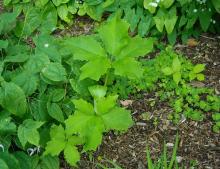
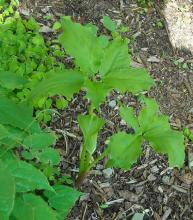
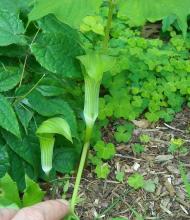
In this photo we find an Arisaema triphyllum flower peeking just above a threesome of Trillium foetidissimum.
Re: Arisaema 2012
Sadly, after growing A. tashiroi here for about 7 years, it did not show in 2011; must try to get this one back again.
That has happened twice for me with Arisaema fanchetianum. Probably because it is growing in soil too heavy to its liking, I think, and the older bulb rots. To my fortune, though, small plants have always appeared from offsets.
Re: Arisaema 2012
One of my other favourites
and first price winner last year in Paris
Arisaema ringens
and a green form Arisaema ringens Green Devil
Roland
Re: Arisaema 2012
Roland, another of my favorites, A. ringens. Didn't know there were cultivar names; they go around here among local chapter NARGS members simply as the green form or black rimmed form. I have one bulb that has never increased in years, the green flowered form. It didn't flower this year, probably from downsizing or sulking after the terrible summer-autumn drought of 2010. Really must get the black-rimmed form sometime.
Rick, my experience with Arisaema franchetianum is somewhat similar to yours. It has never flowered, has shown a few giant rounded leaves some years, might disappear for a year, and emerge another year with but one very large rounded leaf; sometimes (such as summer 2011) not sprouting until July or August after I have long since given the plant up for dead. I have no idea about what it wants, and its sporadic disappearance/reappearance baffles me.
Going through the Arisaema 2010 topic, I am reminded of another loss, the white-veined leaf version of A. triphyllum, a really special form. I believe this one too, was victim of the terrible drought of 2010. Here's the link to that topic, last 3 photos out of 10 show the white-veined leaf Arisaema triphyllum. :(
http://nargs.org/smf/index.php?topic=191.0
Re: Arisaema 2012
Went browsing through my digital images to find some of Arisaema ringens growing at the U.S. National Arboretum, where they grew into an impressive stand. It's hard to tell from the photographs, but these were the black-rimmed flowered form. The leaves were shiny and ENORMOUS. Also found a couple photos of my relatively puny green-flowered form, all from May 2004.
A. ringens at U.S. National Arboretum:
Puny A. ringens by comparison to the USNA plants, flowering in my garden May 2004, the plant now smaller than ever, if indeed it is still alive:
Re: Arisaema 2012
Arisaema ringens Green Devil is a selection from myself
The jury in Paris gave the name
without name no price
The same for Cyclamen hederifolium Purple ear strain
again one of my own selections out of the Rosenteppich strain
The jury member Hans Simon gave that one a name for the same reason
Roland
Re: Arisaema 2012
Here is one photo of A. ringens I took last year at Nick Nikous' garden. It is a huge patch and as you can see was flowering profusely!
I also added a photo from their garden of an Arum, is it Sauromattum venosum?
Re: Arisaema 2012
No Amy
It is Dracunculus vulgaris
but also with a fantastic perfume ;DRoland
Thanks Roland! :D Luckily that day it was not sending out its 'fragrance'! Whew!! :P
Re: Arisaema 2012
Some smell hardly
other ---------------------------------------
but they are soooooooooooooooooooooo beautiful
my biggest flower was almost 70 cm
I grow mine in the hedge on a half shady place
Roland
Re: Arisaema 2012
Ive had D vulgaris to 75 cm... They are wonderful and reliable hardy even here in Z6 when grown in a well drained place.
Martin
Re: Arisaema 2012
I have never tried dracunculus in the garden. I assume they need a hot dry site during the summer and such a place doesn't exist in my garden!
However, I have started trying Arisaema the last few years. Didn't like them before . . . . ???
Two years ago I lost several potfulls of very nice seedlings due to freezing during the winter. However I got more seeds from Chadwell and have several new plants in the garden this winter. Hope they cope better in the ground!
Here is one I got several years ago - don't remember the name though. Picture taken last spring.
Re: Arisaema 2012
That's a beauty Trond!! :o Too bad you don't know which it is...perhaps someone will chime in with the ID.
Re: Arisaema 2012
Mark, I am also excited about my Arisaema seeds from Chris! I hope they will grow well for us!
Speaking of A. triphyllum, I only grow two plants; one is green and white, and the other is one of the typical ones... I would love to see near solid black ones, though!
Roland, I love your 'Green Devil'! Did this selection come from your regular ringens seeds?
Trond, nice looking Arisaema, whatever it is!
Here is a picture from last spring, I can't wait for my Arisaema to flower this year!
Re: Arisaema 2012
Roland, I love your 'Green Devil'! Did this selection come from your regular ringens seeds?
It was just a fantasy name for the jury to get my merite
it was from seed from a few wild collected bulbs
There is also a nice black stemmed one
probably I call that one Black devil for the jury ;D
maybe I can make a good picture this spring
one of the dark ones is on the back-ground
Roland
Re: Arisaema 2012
Trond, not sure what species your Arisaema is, but it sure is a dramatic one, most fetching! You could try going through the long and excellent thread on SRGC Forum entitled "Aroids (the family Araceae)", many Arisaema photos to wade through, maybe one will resemble yours.
Arisaema topic on SRGC, Aroids (the family Araceae):
http://www.srgc.org.uk/forum/index.php?topic=950.0
Saori, what a slender and delicate beauty that A. triphyllum is! I find it fascinating that this species can vary so much. A favorite spring passtime is walking around the garden, seeing the "jacks" here and there, invariably I "lift the hood" on each spathe I find, to see what the inside color and markings might be. The soft all green ones are refreshing too.
Amy, the image of two blooms on A. ringens at Nick Nickou's garden in Connecticut shows a brown-flowered form, rather nice I think, I thought there was only a green or black form, good to know there is more variation. By the way, I have my own nickname for this Arisaema, the Clenched Fist Cobra Lily ;)
Roland, I can see that dark-stemmed black-flowered form of A. ringens hiding in the background, do show us again this spring, what a special form it is. :o
Re: Arisaema 2012
I have an Arisaema species that Darrell Probst gave me, he collected it in China. This year is flowered well once again, with it's very wide shoe-leather brown spathe, a striking form, I consider it one of my treasures. So far it has not set any seed :(
I posted on SRGC where there are some Arisaema specialists, here's my original post on this Chinese Arisaema species:
http://www.srgc.org.uk/forum/index.php?topic=950.msg153081#msg153081
A response from an SRGC forumist, discussing A. taiwanense and A. sukotaiense, suggesting that my plant looked like A. aff. sukotaiense:
http://www.srgc.org.uk/forum/index.php?topic=950.msg154030#msg154030
For comparison, a photo of A. sukotaiense that does look similar, other photos seen under this name don't look as similar.
http://abrimaal.pro-e.pl/araceum/arisaema/sukotaiense.htm
And for more comparison, here is A. taiwanense as shown by David Toole, looks very different, love the long thread-like tips to the leaves. My understanding is that A. taiwanense can be taken as the type for a large and difficult group of allied species.
http://nargs.org/smf/index.php?topic=658.msg13010#msg13010
Now to some photos taken in my garden at the end of May 2011.
On the left, looking under the hood, on the right, backside profile ;)
Overall view and the ornamental fan of leaves:
Re: Arisaema 2012
Thanks, Mark! I did take a look and the most similar one I found is Arisaema elephas although the "proboscis" isn't quite the same form. The leaves are very similar though.
Re: Arisaema 2012
Roland, I love your 'Green Devil'! Did this selection come from your regular ringens seeds?
It was just a fantasy name for the jury to get my merite
it was from seed from a few wild collected bulbs
There is also a nice black stemmed one
probably I call that one Black devil for the jury ;D
maybe I can make a good picture this spring
one of the dark ones is on the back-groundRoland
Roland, it's fun to see lots of variations! Please post pictures of your 'Devil' series when you get flowers.
Saori, what a slender and delicate beauty that A. triphyllum is! I find it fascinating that this species can vary so much. A favorite spring passtime is walking around the garden, seeing the "jacks" here and there, invariably I "lift the hood" on each spathe I find, to see what the inside color and markings might be. The soft all green ones are refreshing too.
Thanks Mark! My green one is still small and is not producing seeds yet, but hopefully I will get a bunch of seed soon and will be able to grow lots of variations of this species!
Re: Arisaema 2012
Mark, the dark Arisaemas of yours are stunning!
Here is one I hope will grow stronger the next years. It has survived the last cold winters! A. candidissimum (sorry - a bad picture!)
Re: Arisaema 2012
Not sure why, but I've never grown A. candidissimum, yours is a nice clean white form. Maybe because purchasing bulbs is expensive, and I have gotten seed of this one yet.
From google images, I see that it can be quite a good pink as well, wonder why most Arisaema have such dark lurid-color blooms (not that there's anything wrong with that, I think I'm in good company of aroid fans intrigued by the dark somber colors, often dramatically striped). For most aroids this has to do with pollinators, maybe I should wonder the opposite, why so few are light and brightly colored. From NARGS Seed Exchange, I did get A. flavum ssp. abbreviatum, one of the few yellows.
Re: Arisaema 2012
With the extra warm temperatures this spring, Arisaema sikokianum is growing lustily this year. This is a threesome grouping, which always faces away from the prime garden viewing direction. Some visual impressions, the first two photos with different lighting, when backlit, the veining shows better.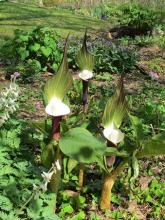
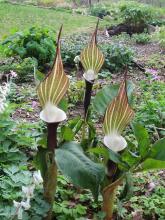
Side profile, and a wider garden view: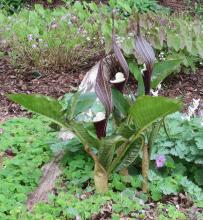
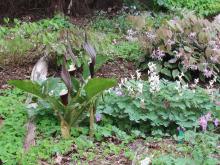
A young self-sown plant blooming for the first time, close to Epimedium fargesii. Notice another seedling to the right. The darn thing has its back to the gardebn access path, as usual!
Re: Arisaema 2012
Several views of one of my favorites, a garden hybrid that appeared about 10 years ago, between the slender A. tashiroi (with beautiful snake-skin like markings on the sheathed sprout) and the common A. amurense. A few years ago I eventually lost tashiroi, but the hybrids and several forms of amurense persist.
Inside, the flowers can be green (with whitsh striping) or tinged with brown. This is one that's growing up through an Epimedium, the spathe brownish inside.
Re: Arisaema 2012
With the extra warm temperatures this spring, Arisaema sikokianum is growing lustily this year. This is a threesome grouping, which always faces away from the prime garden viewing direction. Some visual impressions, the first two photos with different lighting, when backlit, the veining shows better.
Still my all time favourite, Mark. How old is that group? Over here this species doesn't get very old, 5-6 years in the garden!
Last week I saw for the first time ever (in the garden of a friend) an A. sikokianum which propagates vegetatively, it grows small side-bulbs! That would mean getting group of this plant and never losing it again...I've asked him to put me on the waiting list for this clone ;)
Several views of one of my favorites, a garden hybrid that appeared about 10 years ago, between the slender A. tashiroi (with beautiful snake-skin like markings on the sheathed sprout) and the common A. amurense. A few years ago I eventually lost tashiroi, but the hybrids and several forms of amurense persist.
Inside, the flowers can be green (with whitsh striping) or tinged with brown. This is one that's growing up through an Epimedium, the spathe brownish inside.
Wonderful hybrid, Mark. Is it fertile?
A. amurense is one of the easiest over here, and can form very big clumps, very quickly! Never tried A. tashiroi!
The first one to flower over here this year is Arisaema griffithii
Re: Arisaema 2012
Wim, oh no, my A. sikokianum clump-of-three is 6-7 years old, I hope that doesn't mean my clump will die soon! I've had any number of Arisaema die, but I usually attribute the losses due to vole/mole tunneling which is a significant problem here. Typically I scratch in the seed of A. sikokianum in various spots in the garden in late fall, and they come up here and there; can never have enough of this one.
Yes, the A. tashiroi x amurense (or is it the other way round), is indeed fertile. For more on this hybrid, and the delightful A. tashiroi which I have fond memories of, see this past NARGS topic:
http://nargs.org/smf/index.php?topic=191.msg1471#msg1471
Always wanted A. griffithii is one of the most distinctive and remarkable species, definitely on my want list, haven't tried it yet.
Don: ooh, I really like A. costatum, a rather bright red-toned base and dramatic striping. Did you grow yours from seed? How long have you had it in the garden?
Re: Arisaema 2012
I obtained costatum as a small tuber; I've had it in the garden for about seven years. It blooms reliably now, but hasn't multiplied.
Re: Arisaema 2012
Your Arisaemas are so early! here they are the last plants to emerge - often not till midsummer!
Re: Arisaema 2012
A. sikokianum is the earliest to bloom here, much earlier than triphyllum.
Re: Arisaema 2012
Same with me, Trond. Usually the Asian types emerge in late June or July. I don't have A. sikokianum.
Re: Arisaema 2012
Gene, that's quite a view! I think A. sikokianum is one of the most beautiful in this genus and you can't have too many of them!
I had only one sikokianum in my garden but I wanted to get some seeds, so I bought two more plants. Unfortunately, all my plants are still male and I have to wait till one of them turns female... But I found a very rare coloring of A. sikokianum! :D
One thing... My Arisaema kishidae is female right now but I only have one plant and don't have male plants to collect pollen from. Does anybody out there have this plant and if so wouldn't mind sharing some pollen with me? I will share some seeds later if I successfully harvest the fruits or I will trade some of the seeds I have right now. Please let me know!
Re: Arisaema 2012
Seems I have to get hold of A. sikokianum!
Re: Arisaema 2012
Saori, that color variant (a hybrid?) of A. sikokianum is awesome, beautifully presented photographs, I imagine them as Mr. & Mrs. Sikokianum :D Please tell us, was that a spontaneous self-sown plant? Is there a possibility that it hybridized with another Arisaema species?
Gene, I was starting to wonder about my A. sikokianum plants, as they're all facing west, but in your impressive colony, they're facing various directions, so it's probably just coincidence that my flowering plants are facing the same direction.
Re: Arisaema 2012
Mark, as far as I know, this is one of the variations of sikokianum. I found this one as a one-off in a group of more than 100. I believe that the nursery from which I bought it is growing only sikokianum and so I think that this is seed-grown, but I'm not sure. I should have asked... I saw a green version of sikokianum on some Japanese sites before (if you are interested, here is a good link: http://blogs.yahoo.co.jp/fu2ran/59116249.html) and, though I have only heard that it exists, there is also a red version of sikokianum. If my other sikokianum turns out to be female next year, I will use a pink sikokianum that I have to pollinate it, and hopefully I can take the F1 and cross it back again, so that I can hopefully create a pink sikokianum.
Re: Arisaema 2012
The two earliest arisaemas to bloom here are ternatipartitum (shown) and kishidae, which both open their "jacks" in early April before the leaves arise and tolerate temps below freezing after opening.
Re: Arisaema 2012
The two earliest arisaemas to bloom here are ternatipartitum (shown) and kishidae, which both open their "jacks" in early April before the leaves arise and tolerate temps below freezing after opening.
Some more to look for! I am always interested in early flowering plants. Are they woodlanders?
Re: Arisaema 2012
Yup, and pretty easy ones; ternatipartitum in particular rapidly clumps up.
Re: Arisaema 2012
A new one ;D Literally.
And that is new to science or to you? Very pretty!
Re: Arisaema 2012
Cool looking Arisaema Aaron, a distinctive flower shape.
Speaking of distinctively shaped Arisaema plants, here's one that appeared in my garden, I had just assumed it was a small grouping of A. triphyllum seedlings that pop up all over the place. It has three narrowish leaflets that stand straight up, and an open upright flower, tall and slender growing overall. What could it be? In the scene, Trillium grandiflorum and the low T. foetidissimum are blooming, leaves of regular A. triphyllum are there too. In the photo on the right is a view showing Trillium foetidissimum and the stem bases of the mystery Arisaema on the left and a regular A. triphyllum on the right.
Mystery Arisaema, self sown seedlings: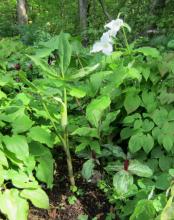
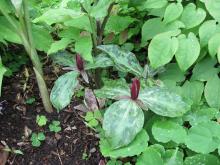
On the left, closeup of the mystery Arisaema, on the right-hand photo, the folded-lid flower of regular A. triphyllum on the left, and the open spathe of the mystery one on the right.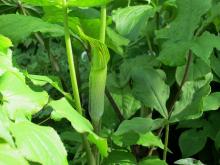
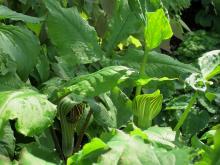
From Darrell Probst, this is A. kishidae, diaphanous nearly see-through flowers and nicely marked leaves. Behind it is the emerging shoot of another Arisaema "sp." that Darrell collected in China, that might be close to A. taiwanense or A. sukotaiense.
For context, this link is to my original post on an Arisaema sp. collected by Darrell Probst in China:
http://www.srgc.org.uk/forum/index.php?topic=950.msg153081#msg153081
...and a response from an SRGC forumist, discussing A. taiwanense and A. sukotaiense:
http://www.srgc.org.uk/forum/index.php?topic=950.msg154030#msg154030
Arisaema aff. sukotaiense
Last, is a nice little grouping of A. triphyllum seedlings flowering for the first time; I like the reddish stems catching sunlight. As cute as they are, some forms of A. triphyllum get large and will take up too much space, so I might need to move these to a different location next year.
Another one from Darrell Probst, a dwarf speckled version of A. amurense, really cute... can't remember where he said he collected this one.
Re: Arisaema 2012
At last! Arisaema elephas shows signs of life. It is always late however. (I believe it is elephas but am not sure.)
Re: Arisaema 2012
Here are the flowers. I have 3 different plants and although the leaves are very similar the inflorescences are not. The second one flowers a week before the others too.
Edit: I got a name for the middle one on SRGC site: Arisaema wilsonii!
Re: Arisaema 2012
The second doesn't look as Arisaema elephas
Roland
Re: Arisaema 2012
The second doesn't look as Arisaema elephas
Roland
You are right, Roland! It is probably A wilsonii. However, the leaves are remarkably similar!
Re: Arisaema 2012
All I got these days... Arisaema triphyllum: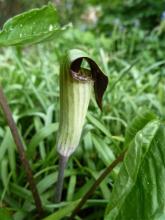
I've never noticed seeds forming, but I guess they must have, as I noticed a plant in a new spot this evening.
Re: Arisaema 2012
I also have some plants that do not set seeds. However I just read that Arisaema is unique in changing sex during their lifetime. They starts as males and later changes to females but can continue changing. I know shrimps do the same, start as males and change to females at the age of 5!
Maybe that's why some plants don't set seeds.
Re: Arisaema 2012
Here Arisaema candidissimum starts flowering
grown from seeds , it took 4 years
Roland
Re: Arisaema 2012
Hello Arisaema fans, I'm intrigued by all Arisaema, and all those that have been posted here are great to see and learn about. I have taken many photos during the 2012 year with intent of posting the photos, but available time proved too much of a challenge. I hope to catch up over the fall and winter months. But here's a timely one, the "fruit cones" on a rather remarkable hybrid (Arisaema triphyllum x tashiroi), a large robust plant with huge triphyllum-like leaves, but with a taller stem and the unique snake-like striped leaf-sheathes on the stem. I have recently harvested the "berries", sowing half of them, giving the other half to a friend and superb grower Marsha Russell.
The fruits were very squishy, just touch them and they popped with juice and spit out a few seeds. My friend Marsha tells me that A. triphyllum has but one seed per "berry", whereas this one has up to 6 seeds per berry. One can clean the seed, but be forwarned, you may want to wear gloves, as the berries seem to have an astringent that can lead to blistering or skin-layer shedding. Personally, I prefer to sow whole-berry, scratched into the soil near the mother plant, and always gets lots of seedlings. In the photos below, this year I sowed a couple flats using whole berries, they should germinate in spring just fine.
Re: Arisaema 2012
My plants usually don't set berries or if they do the berries quickly disappear :-\ I am sorry I have never seen seedlings in my garden either :( as any increase in my Arisaema population would be most welcome!
Re: Arisaema 2012
In the photos below, this year I sowed a couple flats using whole berries, they should germinate in spring just fine.
Hello Mark
'berry' informative pics --sorry about the pun ---i just couldn't help myself ;D ;D
I'm intrigued by your 'flats'---they seem quite shallow or is it just the angle of the photo ?.
While most of the Arisaemas here are just breaking the surface in pots, troughs and the garden proper, this one is up and in full flower--grown from seed but label long gone --hopefully i'm correct in keying it out as A.amurense.
Cheers Dave.
Re: Arisaema 2012
Hi Dave, the peat flats are normal depth (several inches), it's just the angle of the photograph giving an illusion of being shallow. The blue styrofoam flats are actually repurposed flats, more shallow than the peat flats, these are from packages of mushrooms that I buy from the grocery store, I poke drainage holes through the bottom with a pencil, they make pretty good flats for seed germination, and maybe will last longer than the peat flats which decompose in a year or so.
I agree with your ID of Arisaema amurense. :)
Re: Arisaema 2012
Gene,
That should be A. heterophyllum? Dracontium has the inflorescence below the leaves. I have many of them from several parts of the range, but no see whatsoever this year on Arisaema. Too much rain all spring.
After some googling, I think you are right. The leaf form is very similar on the two species.











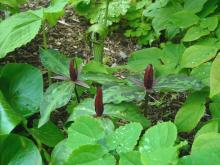
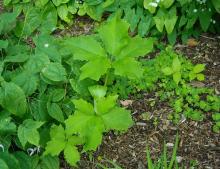
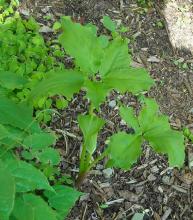
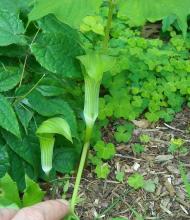
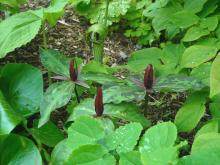
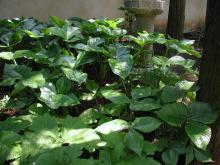
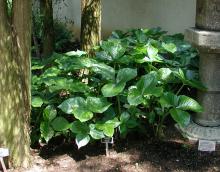
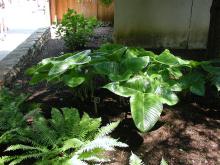
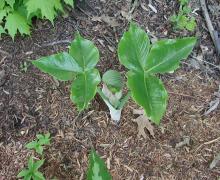
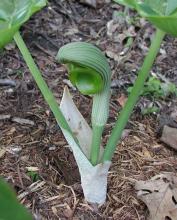
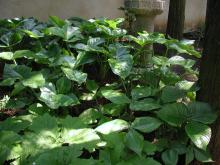
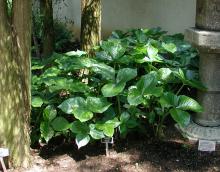
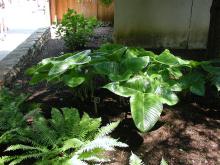
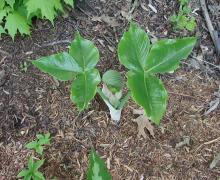
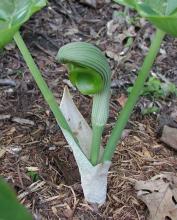
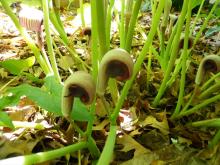
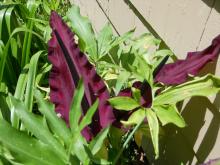
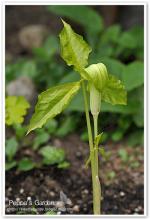
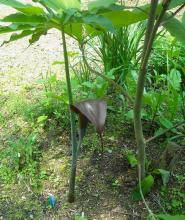
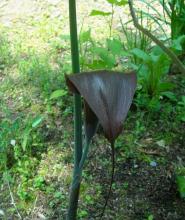
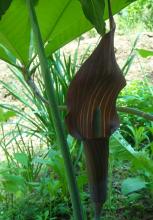
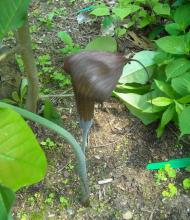
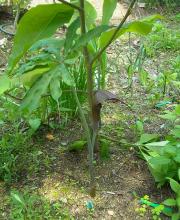
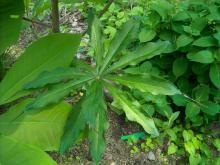
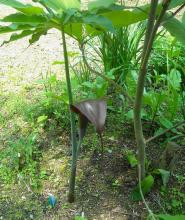

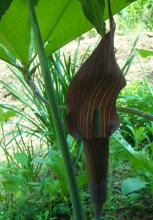
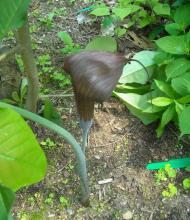
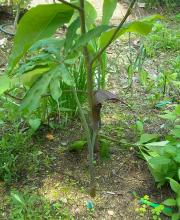
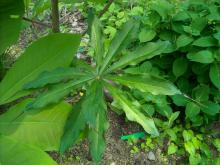
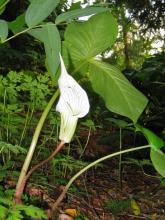
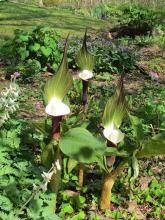
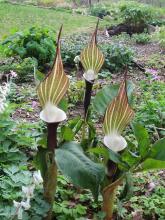
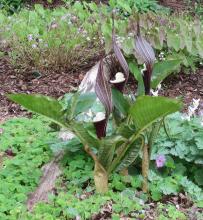
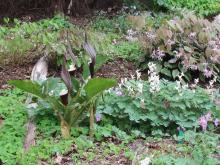
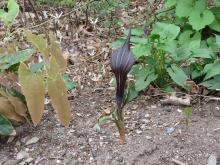
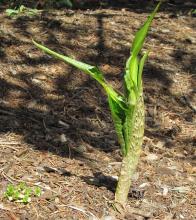
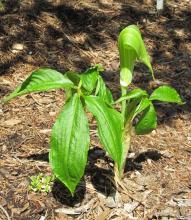
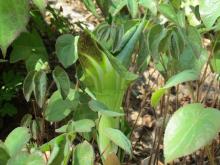
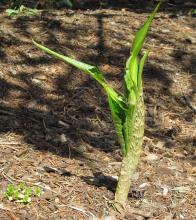
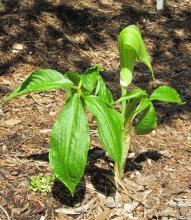
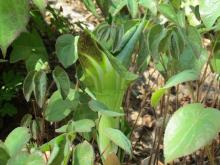
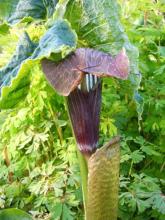

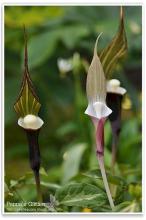
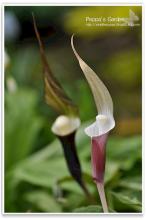
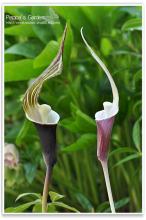
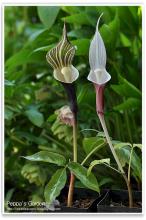
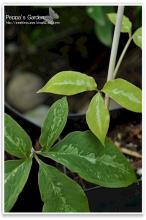
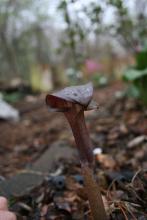
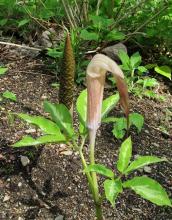
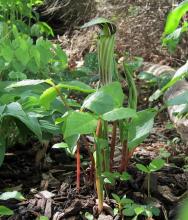
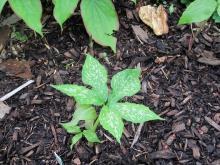
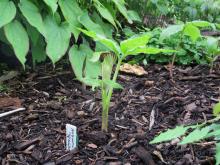
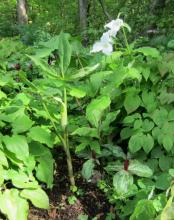
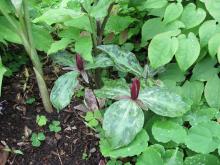
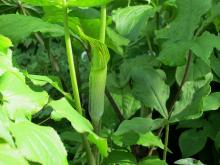
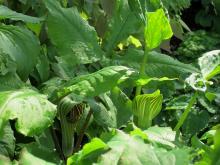
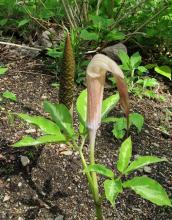
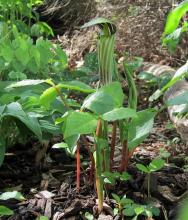
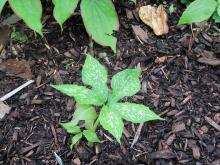
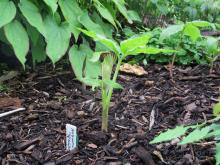
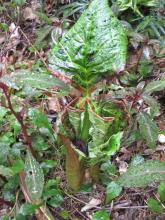
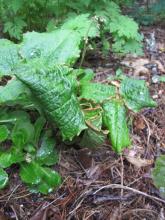
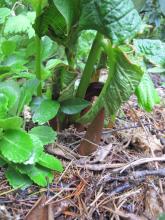
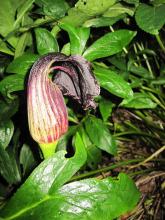
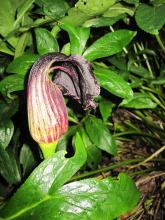
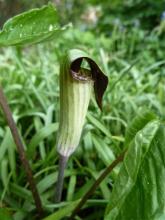
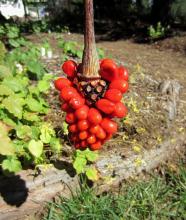
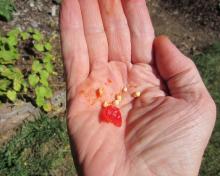

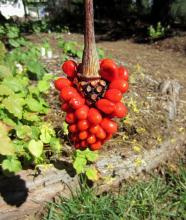
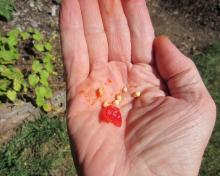
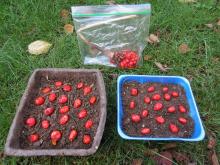
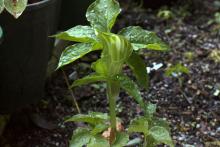
One of my favourites
completely dormant in the moment
so a picture from last summer
from this fantastic Arisaema kiushianum
Roland